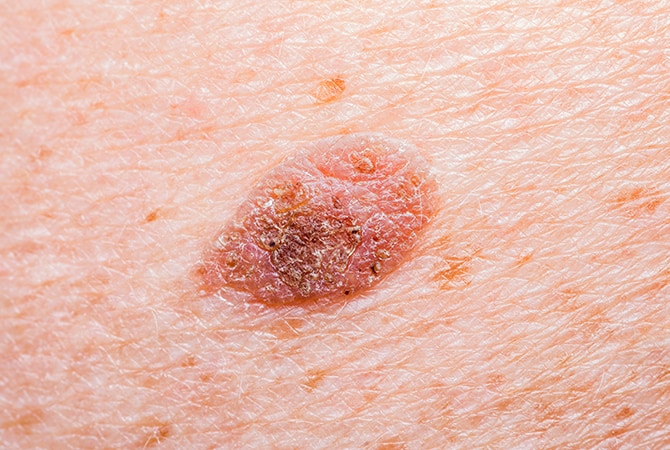Seborrheic Keratosis Symptoms, Causes, Diagnosis and Treatment

What Is Seborrheic Keratosis?
It is a common skin concern, characterized by benign skin growth. The condition usually targets older and middle-aged adults. Few individuals get just a single; however, most individuals tend to experience many. Fortunately, these skin growths are non-infectious. Usually, seborrheic keratosis begins as dry, small bumps. Gradually, it thickens forming a warty-looking appearance. Furthermore, seborrheic keratoses can vary in color. Most of which are brown or tan. These skin growths may resemble actinic keratoses, warts or moles.
Mention The Alternate Names Of Seborrheic Keratosis:
Seborrheic Keratosis Is Also Known By The Following Names:
- Senile Keratosis.
- Seborrheic Keratois.
- Keratosis Benign Skin Tumors.
What Are The Symptoms Of Seborrheic Keratosis?
Prominent symptom of seborrheic keratosis is the skin growth which often occurs in the back, shoulders, chest, face or some other body area. These skin growths are painless, however may get irritated and cause itching. Commonly observed color of these skin growths are black, brown, or tan with a flat, raised surface.
Seborrheic keratosis can have a rough texture and waxy surface. They are usually oval or round in shape. Mostly, they emerge in forms of clusters.
When Is The High Time To Seek Medical Advice?
Call up for an appointment with your dermatologist in case you notice any of the above mentioned symptoms. Also, seek medical advice incase:
- Any changes occur in the growth appearance.
- Emergence of new growths.
What Causes Seborrheic Keratosis?
Researchers have failed to understand what exactly causes the skin growth; however the following factor may contribute in its instigation:
- Sunlight: since, seborrheic keratosis commonly emerges in body parts which are more sun exposed, chances are, that UV light plays an active role in its occurrence.
- Genetics: the condition is observed to run in families.
- According to the dermatologists, the condition is caused by the accumulation of normal skin cells.
No virus has any contribution in the development of seborrheic keratosis.
How Is Seborrheic Keratosis Diagnosed?
You need to visit a dermatologist for the purpose. He or she will carefully examine your affected skin during the visit. In order to confirm its seborrheic keratosis, the dermatologist will suggest skin biopsy.
How Is Seborrheic Keratosis Treated?
An individual with seborrheic keratosis does not need any medical treatment unless these skin growths are greatly affecting your appearance. Also, you will need these skin growths to be treated in case they become irritated and causing you itching. For the purpose, the dermatologist will recommend you any of the following options:
- Freezing (cryotherapy).
- Surgery.
What Is The Prognosis Of Seborrheic Keratosis?
Removing seborrheic keratosis is easy; on the other hand, its removal does not consequent in scarring. Though, one may observe lighter skin patches where once growths were. Fortunately, seborrheic keratosis is not a recurring skin condition, after being removed; growth does not recur in majority instances. Though, being prone to seborrheic keratosis increases one’s chances to develop more skin growths in the long run.
Related Articles :
Ecthyma Symptoms, Causes, Diagnosis and Treatment
Diaper Dermatitis Symptoms, Causes, Diagnosis and Treatment
Chronic Lymphocytic Leukemia Symptoms, Causes, Diagnosis and Treatment
Bartonellosis Symptoms, Causes, Diagnosis and Treatment
Pruritus Symptoms, Causes, Diagnosis and Treatment
Measles Symptoms, Causes, Diagnosis and Treatment
Keratosis Pilaris Symptoms, Causes, Diagnosis and Treatment
Impetigo Symptoms, Causes, Diagnosis and Treatment
Idiopathic Thrombocytopenic Purpura Symptoms, Causes, Diagnosis and Treatment
Ichthyosis Vulgaris Symptoms, Causes, Diagnosis and Treatment
Scleroderma Symptoms, Causes, Diagnosis and Treatment
Porphyria Symptoms, Causes, Diagnosis and Treatment
Polycythemia Vera Symptoms, Causes, Diagnosis and Treatment
Hidradenitis Suppurativa Symptoms, Causes, Diagnosis and Treatment
Hyperhidrosis Symptoms, Causes, Diagnosis and Treatment
Lichen Planus Symptoms, Causes, Diagnosis and Treatment
By : Natural Health News




